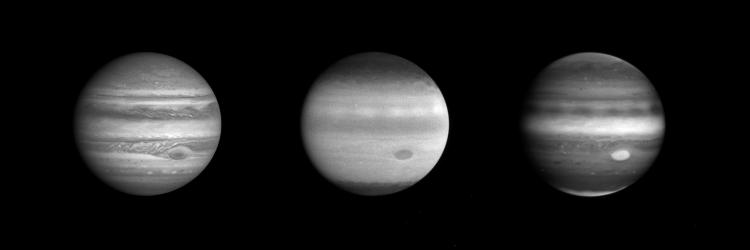Three Wavelengths

| PIA Number | PIA02822 |
|---|---|
| Language |
|
Jupiter in blue, ultraviolet and near infrared
October 23, 2000
These three images of Jupiter, taken through the narrow angle camera of
NASA's Cassini spacecraft from a distance of 77.6 million kilometers (48.2
million miles) on October 8, reveal more than is apparent to the naked eye
through a telescope.
The image on the left was taken through the blue filter. The one in the
middle was taken in the ultraviolet. The one on the right was taken in the
near infrared.
The blue-light filter is within the part of the electromagnetic spectrum
detectable by the human eye. The appearance of Jupiter in this image is,
consequently, very familiar. The Great Red Spot (below and to the right of
center) and the planet's well-known banded cloud lanes are obvious. The
brighter bands of clouds are called zones and are probably composed of
ammonia ice particles. The darker bands are called belts and are made dark
by particles of unknown composition intermixed with the ammonia ice.
Jupiter's appearance changes dramatically in the ultraviolet and near
infrared images. These images are near negatives of each other and
illustrate the way in which observations in different wavelength regions
can reveal different physical regimes on the planet.
All gases scatter sunlight efficiently at short wavelengths; this is why
the sky appears blue on Earth. The effect is even more pronounced in the
ultraviolet. The gases in Jupiter's atmosphere, above the clouds, are no
different. They scatter strongly in the ultraviolet, making the deep
banded cloud layers invisible in the middle image. Only the very high
altitude haze appears dark against the bright background. The contrast is
reversed in the near infrared, where methane gas, abundant on Jupiter but
not on Earth, is strongly absorbing and therefore appears dark. Again the
deep clouds are invisible, but now the high altitude haze appears
relatively bright against the dark background. High altitude haze is seen
over the poles and the equator.
The Great Red Spot, prominent in all images, is obviously a feature whose
influence extends high in the atmosphere. As the Cassini cameras continue
to return images of Jupiter, it will be possible to construct a
three-dimensional picture of how clouds form and evolve by watching the
changing appearance of Jupiter in different spectral regions.
JPL manages the Cassini mission for NASA's Office of Space Science,
Washington, D.C. JPL is a division of the California Institute of
Technology in Pasadena.
Credit: NASA/JPL/University of Arizona, (PIA02822)
For higher resolution, click here.
